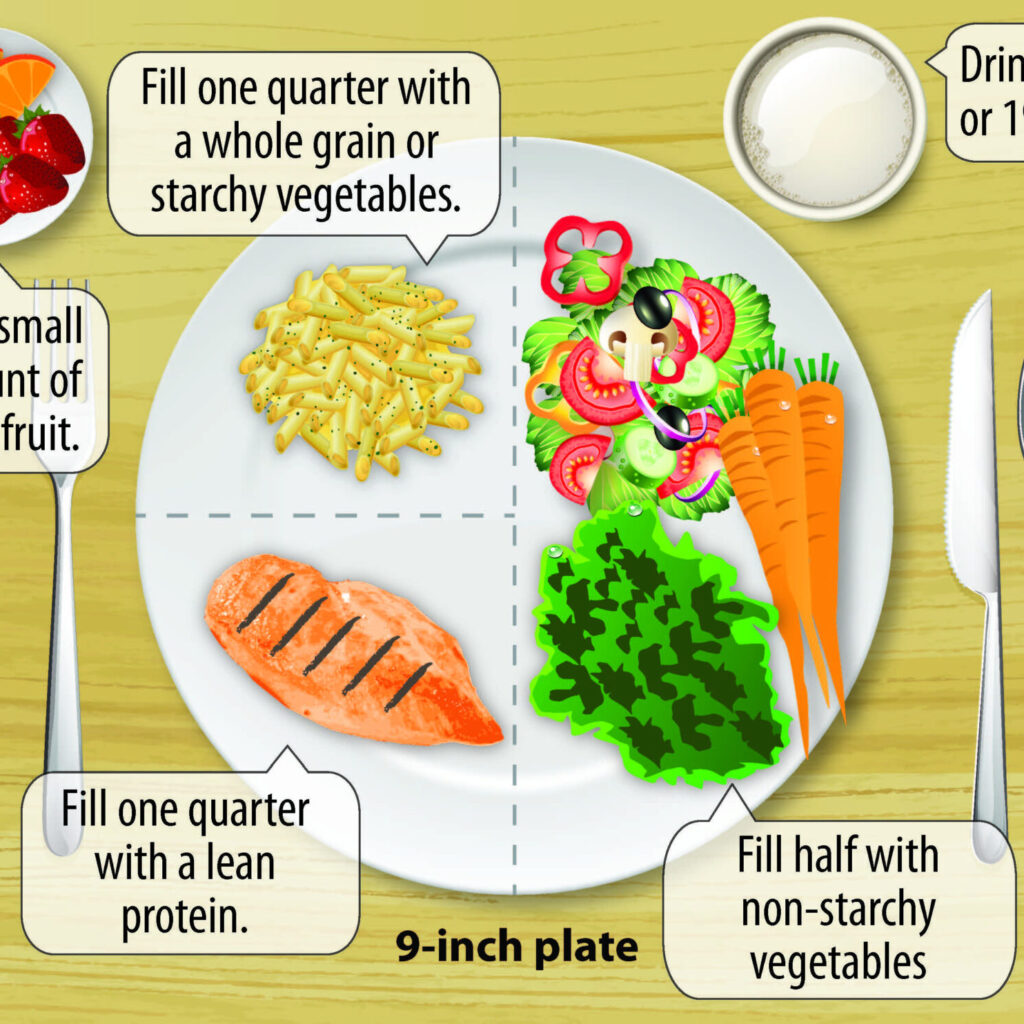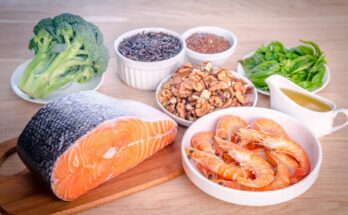
If you have diabetes, you may wonder what you can eat to keep your blood sugar levels under control and prevent complications. You may also feel overwhelmed by the amount of information and advice you get from different sources. How do you know what is the best healthy eating plans for diabetes management for you?
In this article, I will explain what diabetes is, how it affects your body, and why eating well is important. I will also give you some general tips and examples of healthy eating plans for diabetes management. Finally, I will answer some frequently asked questions and provide some resources for further information.
What is Diabetes?

Diabetes is a chronic condition that affects how your body uses glucose, a type of sugar that is the main source of energy for your cells. Glucose comes from the food you eat and is carried by your blood to your cells. To enter your cells, glucose needs a hormone called insulin, which is produced by your pancreas.
In diabetes, either your pancreas does not make enough insulin, or your cells do not respond well to insulin, or both. This causes glucose to build up in your blood, leading to high blood sugar levels. Over time, high blood sugar levels can damage your nerves, blood vessels, and organs, and increase your risk of heart disease, stroke, kidney failure, blindness, and amputation.
There are two main types of diabetes: type 1 and type 2. Type 1 diabetes is an autoimmune disease, where your immune system attacks and destroys the cells in your pancreas that make insulin. Type 1 diabetes usually develops in childhood or adolescence, and requires daily injections of insulin to survive.
Type 2 diabetes is more common and often develops later in life. It is caused by a combination of genetic and lifestyle factors, such as being overweight, physically inactive, or having a family history of diabetes. In type 2 diabetes, your pancreas either does not make enough insulin, or your cells become resistant to insulin, or both. Type 2 diabetes can be managed with oral medications, insulin injections, or both, depending on your blood sugar levels and your doctor’s advice.
Why is Eating Well Important for Diabetes Management?

Eating well is one of the key factors in managing diabetes, along with taking your medications, monitoring your blood sugar levels, and being physically active. Eating well can help you:
- Control your blood sugar levels and prevent them from going too high or too low, which can cause symptoms such as thirst, hunger, fatigue, blurred vision, headaches, mood swings, and even coma or death in extreme cases.
- Manage your weight and prevent obesity, which can worsen insulin resistance and increase your risk of complications.
- Lower your blood pressure and cholesterol levels, which can reduce your risk of heart disease and stroke.
- Improve your overall health and well-being, and prevent or delay the onset of diabetes-related complications.
How to Eat Well with Diabetes?

There is no one-size-fits-all eating plan for diabetes management. Different people have different needs, preferences, and goals, and may respond differently to different foods and diets. However, there are some general principles and guidelines that can help you eat well with diabetes. These include:
- Eat regular meals and snacks, and avoid skipping or delaying them. This can help you keep your blood sugar levels stable and prevent them from dropping too low or spiking too high. Aim to eat every 3 to 4 hours, and have a balanced meal or snack that contains carbohydrates, protein, and healthy fats.
- Choose healthy carbohydrates, and limit or avoid added sugars and refined grains. Carbohydrates are the main source of glucose for your body, and they affect your blood sugar levels the most. However, not all carbohydrates are created equal. Some carbohydrates are healthier than others, and some can raise your blood sugar levels faster than others. Healthy carbohydrates are those that are rich in fiber, vitamins, minerals, and antioxidants, and have a low glycemic index (GI), which means they cause a slower and lower rise in blood sugar levels. Examples of healthy carbohydrates include fruits, vegetables, whole grains, legumes, nuts, seeds, and low-fat dairy products. Added sugars and refined grains are those that are processed and stripped of their natural nutrients and fiber, and have a high GI, which means they cause a rapid and high spike in blood sugar levels. Examples of added sugars and refined grains include table sugar, honey, syrups, candies, cakes, cookies, pastries, sodas, juices, white bread, white rice, white pasta, and cereals. These foods should be limited or avoided, as they can contribute to weight gain, tooth decay, and inflammation, and increase your risk of complications.
- Include lean protein and healthy fats in your meals and snacks. Protein and fat can help you feel full and satisfied, and slow down the digestion and absorption of carbohydrates, which can help you control your blood sugar levels. Lean protein is protein that is low in saturated fat and cholesterol, and high in essential amino acids, which are the building blocks of your muscles, organs, hormones, and enzymes. Examples of lean protein include skinless poultry, fish, eggs, low-fat dairy products, tofu, tempeh, edamame, and seitan. Healthy fats are fats that are unsaturated, which means they have a positive effect on your blood cholesterol levels and heart health. Examples of healthy fats include olive oil, canola oil, avocado, nuts, seeds, and fatty fish, such as salmon, tuna, mackerel, and sardines. These foods also contain omega-3 fatty acids, which are anti-inflammatory and beneficial for your brain and eye health.
- Eat more non-starchy vegetables, and limit or avoid starchy vegetables. Vegetables are an excellent source of fiber, vitamins, minerals, antioxidants, and phytochemicals, which are plant compounds that have various health benefits. However, some vegetables are higher in carbohydrates than others, and can affect your blood sugar levels differently. Non-starchy vegetables are those that are low in carbohydrates and calories, and high in water and fiber, which can help you fill up and control your blood sugar levels. Examples of non-starchy vegetables include leafy greens, broccoli, cauliflower, cabbage, Brussels sprouts, celery, cucumber, zucchini, mushrooms, peppers, tomatoes, onions, garlic, and herbs. You can eat as many non-starchy vegetables as you like, and aim to fill half of your plate with them at each meal. Starchy vegetables are those that are higher in carbohydrates and calories, and lower in water and fiber, which can cause a higher and faster rise in blood sugar levels. Examples of starchy vegetables include potatoes, sweet potatoes, corn, peas, carrots, beets, and winter squash. These foods should be eaten in moderation, and counted as part of your carbohydrate intake. Aim to fill one quarter of your plate with starchy vegetables or other carbohydrate foods at each meal.
- Drink plenty of water, and limit or avoid sugary drinks and alcohol. Water is essential for your body’s functions, and can help you stay hydrated, flush out toxins, regulate your body temperature, and prevent constipation. Water also has no calories or carbohydrates, and can help you control your appetite and weight. Aim to drink at least 8 glasses of water a day, and more if you are physically active, sick, or in a hot or humid environment. Sugary drinks and alcohol are beverages that are high in calories, carbohydrates, and sugar, and can raise your blood sugar levels quickly and significantly. Examples of sugary drinks include sodas, juices, sports drinks, energy drinks, and sweetened coffee or tea. Examples of alcohol include beer, wine, liquor, and cocktails. These drinks should be limited or avoided, as they can contribute to weight gain, dehydration, and complications. If you choose to drink alcohol, do so in moderation, and always with food and water. Moderation means no more than one drink per day for women, and no more than two drinks per day for men. One drink is equivalent to 12 ounces of beer, 5 ounces of wine, or 1.5 ounces of liquor.
Examples of Healthy Eating Plans for Diabetes Management

There are different ways to create a healthy eating plan for diabetes management, depending on your preferences, goals, and needs. Some of the most popular and effective eating plans for diabetes management are:
- The Plate Method. This is a simple and visual way to plan your portions and balance your meals, without any counting, calculating, or measuring. As explained above, you start with a 9-inch dinner plate, and fill half of it with non-starchy vegetables, one quarter with lean protein, and one quarter with carbohydrate foods. You can also add a glass of water or a low-calorie drink, and a piece of fruit or a low-fat dairy product for dessert. This method can help you get enough nutrients, fiber, and variety, and control your blood sugar levels and weight.
- Carb Counting. This is a more flexible and precise way to plan your meals, based on the amount and type of carbohydrates you eat. Carbohydrates are the main factor that affects your blood sugar levels, so by keeping track of how many grams of carbohydrates you eat, and setting a limit for each meal and snack, you can better manage your blood sugar levels and insulin doses. To use this method, you need to know how many grams of carbohydrates are in different foods, and how many grams of carbohydrates you can eat at each meal and snack, depending on your blood sugar levels, medications, and activity level. You can use food labels, nutrition databases, apps, or books to find out the carbohydrate content of foods and consult your doctor or dietitian to determine your individual carbohydrate needs and goals. You can also use a food scale, measuring cups, or your hand to estimate your portions and carbohydrate intake. This method can help you adjust your insulin doses, enjoy a variety of foods, and prevent overeating or under eating carbohydrates.
- The Glycemic Index. This is a way to rank foods based on how they affect your blood sugar levels after you eat them. Foods that have a high glycemic index (GI) cause a rapid and high spike in blood sugar levels, while foods that have a low GI cause a slower and lower rise in blood sugar levels. By choosing foods that have a low or medium GI, and combining them with protein and fat, you can lower the overall GI of your meals and snacks, and control your blood sugar levels better. To use this method, you need to know the GI of different foods, and how to balance them with other foods. You can use tables, charts, apps, or books to find out the GI of foods, and follow some general tips, such as:
- Choose whole grains, legumes, fruits, vegetables, nuts, and seeds, which are usually low or medium GI foods, and limit or avoid white bread, white rice, white pasta, potatoes, corn, and sugary foods, which are usually high GI foods.
- Eat foods that are less processed, cooked, or ripe, as these factors can increase the GI of foods.
- Add protein and fat to your meals and snacks, as these can lower the GI of foods and slow down the digestion and absorption of carbohydrates.
- Eat smaller and more frequent meals and snacks, as this can prevent large fluctuations in your blood sugar levels.
This method can help you choose healthier foods, improve your blood cholesterol levels, and reduce your appetite and hunger.
RELATED
Healthy Eating Plan for Weight Loss
Healthy Eating Plan for Dietary and Specific Needs
Conclusion
Eating well is an essential part of diabetes management, as it can help you control your blood sugar levels, prevent or delay complications, and improve your overall health and well-being. There is no one best eating plan for diabetes management, as different people have different needs, preferences, and goals. However, some general principles and guidelines that can help you eat well with diabetes are:
- Eat regular meals and snacks, and avoid skipping or delaying them.
- Choose healthy carbohydrates, and limit or avoid added sugars and refined grains.
- Include lean protein and healthy fats in your meals and snacks.
- Eat more non-starchy vegetables, and limit or avoid starchy vegetables.
- Drink plenty of water, and limit or avoid sugary drinks and alcohol.
You can also use different methods to plan your meals, such as the plate method, carb counting, or the glycemic index, depending on your blood sugar levels, medications, and activity level. You can consult your doctor or dietitian to help you create a personalized eating plan that suits your needs and goals, and monitor your blood sugar levels regularly to see how different foods and meals affect you.
FAQs
Here are some frequently asked questions and answers about healthy eating plans for diabetes management:
- Q: What are some examples of healthy snacks for diabetes?
- A: Some examples of healthy snacks for diabetes are:
- A handful of nuts or seeds, such as almonds, walnuts, pistachios, sunflower seeds, or pumpkin seeds.
- A piece of fruit, such as an apple, orange, pear, or banana, with a tablespoon of peanut butter or almond butter.
- A cup of low-fat yogurt, cottage cheese, or kefir, with some berries, granola, or flax seeds.
- A slice of whole wheat bread, pita, or tortilla, with some hummus, cheese, or turkey.
- A hard-boiled egg, a string cheese, or a low-fat cheese stick, with some baby carrots, cherry tomatoes, or celery sticks.
- A small bowl of oatmeal, quinoa, or barley, with some milk, cinnamon, and raisins.
- Q: How much sugar can I have with diabetes?
- A: There is no specific amount of sugar that you can have with diabetes, as different people have different blood sugar levels, medications, and activity levels. However, as a general rule, you should limit or avoid added sugars and refined grains, which are high in calories, carbohydrates, and sugar, and can raise your blood sugar levels quickly and significantly. Added sugars and refined grains include table sugar, honey, syrups, candies, cakes, cookies, pastries, sodas, juices, white bread, white rice, white pasta, and cereals. These foods should be eaten in moderation, and counted as part of your carbohydrate intake. You can use natural sweeteners, such as stevia, monk fruit, or erythritol, which have no calories or carbohydrates, and do not affect your blood sugar levels. You can also use spices, such as cinnamon, nutmeg, or vanilla, which can add flavor and sweetness to your foods and drinks, without adding calories or carbohydrates.
- Q: Can I eat fruit with diabetes?
- A: Yes, you can eat fruit with diabetes, as fruit is a healthy source of carbohydrates, fiber, vitamins, minerals, antioxidants, and phytochemicals, which can benefit your health and well-being. However, you should be mindful of the amount and type of fruit you eat, as fruit contains natural sugars, which can affect your blood sugar levels. You should choose fruits that are low or medium in glycemic index (GI), which means they cause a slower and lower rise in blood sugar levels, and avoid or limit fruits that are high in GI, which means they cause a rapid and high spike in blood sugar levels. Some examples of low or medium GI fruits are berries, apples, pears, oranges, grapefruits, peaches, plums, cherries, and kiwis. Some examples of high GI fruits are bananas, grapes, pineapples, mangoes, and watermelons. You should also eat whole fruits, rather than juices or dried fruits, as whole fruits have more fiber, water, and nutrients, and less sugar and calories, than juices or dried fruits. You should also eat fruit with some protein and fat, such as nuts, seeds, yogurt, cheese, or peanut butter, as this can lower the GI of fruit and slow down the digestion and absorption of carbohydrates. You should also eat fruit as part of your meal or snack, and not on an empty stomach, as this can prevent a sudden drop or spike in your blood sugar levels.
- Q: Can I eat rice with diabetes?
- A: Rice is a staple food in many cuisines and cultures, and can be a source of carbohydrates, energy, and nutrients for your body. However, rice can also affect your blood sugar levels, depending on the amount and type of rice you eat. Rice is a starchy food, which means it is high in carbohydrates and calories, and can raise your blood sugar levels quickly and significantly. However, not all rice is created equal. Some rice is healthier than others, and some can raise your blood sugar levels faster than others. You should choose rice that is whole grain, such as brown rice, black rice, red rice, or wild rice, and avoid or limit rice that is white or polished, such as white rice, jasmine rice, or basmati rice. Whole grain rice is rice that has not been processed or stripped of its bran and germ, which are the outer layers of the rice grain that contain most of the fiber, vitamins, minerals, and antioxidants. White or polished rice is rice that has been processed or stripped of its bran and germ, and only contains the endosperm, which is the inner layer of the rice grain that contains mostly starch. Whole grain rice has more fiber, nutrients, and flavor, and less starch, than white or polished rice. Whole grain rice also has a lower glycemic index (GI), which means it causes a slower and lower rise in blood sugar levels, than white or polished rice, which has a higher GI, which means it causes a rapid and high spike in blood sugar levels. You should also eat rice in moderation, and count it as part of your carbohydrate intake. You should also eat rice with some protein and fat, such as beans, lentils, chicken, fish, eggs, tofu, nuts, seeds, or oil, as this can lower the GI of rice and slow down the digestion and absorption of carbohydrates. You should also eat rice with some non-starchy vegetables, such as leafy greens, broccoli, cauliflower, cabbage, celery, cucumber, zucchini, mushrooms, peppers, tomatoes, onions, garlic, or herbs, as this can add fiber, nutrients, and variety to your meal, and help you fill up and control your blood sugar levels.
- Q: What are some good breakfast ideas for diabetes?
- A: Breakfast is an important meal of the day, as it can help you start your day with energy, nutrients, and blood sugar control. However, many traditional breakfast foods, such as pancakes, waffles, muffins, croissants, donuts, cereals, and jams, are high in carbohydrates, sugar, and fat, and can raise your blood sugar levels quickly and significantly. You should avoid or limit these foods, and choose healthier breakfast options, such as:
- A bowl of oatmeal, quinoa, or barley, with some milk, nuts, seeds, berries, cinnamon, and stevia.
- A whole wheat toast, pita, or tortilla, with some peanut butter, almond butter, cheese, or hummus, and some sliced banana, apple, or pear.
- A scrambled, boiled, or poached egg, with some whole wheat bread, cheese, avocado, tomato, and spinach.
- A low-fat yogurt, cottage cheese, or kefir, with some granola, flax seeds, chia seeds, and blueberries, raspberries.


